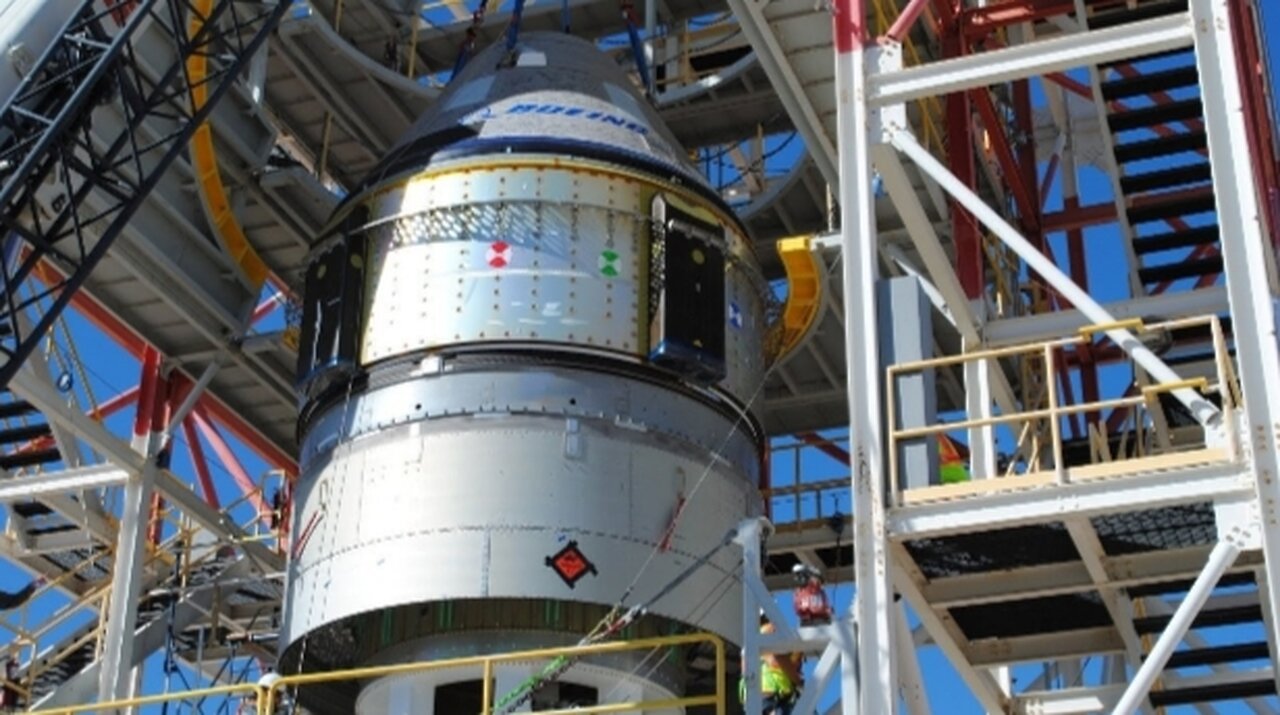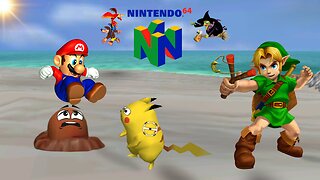Premium Only Content

Pad Abort Test of Boeing's Starliner Spacecraft, Nov. 4, 2019
The test unfolded against the expansive backdrop of the White Sands Missile Range, a strategic location chosen for its suitability in simulating and evaluating real-world launch scenarios. As the clock struck 9:15 a.m. EST, the Starliner spacecraft roared to life, accentuating Boeing's commitment to rigorous testing and safety protocols. This demonstration wasn't just a routine exercise; it symbolized a proactive approach to mitigating potential risks associated with space travel, emphasizing the paramount importance of astronaut safety.
The launch abort system, a critical component of the Starliner spacecraft, represents a fail-safe mechanism designed to rapidly propel the crew capsule away from the rocket in the event of an emergency, thereby minimizing potential dangers. The successful execution of this test bolstered confidence in the spacecraft's overall safety architecture, reaffirming Boeing's dedication to ensuring the well-being of astronauts entrusted to their technology.
The meticulous planning that led to the Nov. 4 test underscored the aerospace giant's commitment to precision and preparedness. Every aspect of the launch abort system's functionality was scrutinized, from its rapid response time to the seamless coordination with ground control. The exercise simulated a scenario where the launch sequence faced an unforeseen anomaly, requiring an immediate evacuation of the crew. The flawless execution of this drill echoed Boeing's proficiency in engineering and execution, showcasing the culmination of extensive research, development, and testing.
As the Starliner spacecraft soared into the sky, it carried with it the aspirations of a new era in space exploration—one characterized by resilience, adaptability, and a relentless pursuit of safety. The White Sands Missile Range bore witness to the culmination of years of collaborative effort, involving engineers, scientists, and space enthusiasts, all driven by the collective vision of advancing humanity's reach into the cosmos.
The Nov. 4 test not only assessed the launch abort system's technical prowess but also served as a testament to the collaborative spirit of the Commercial Crew Program. The endeavor brought together experts from various disciplines, fostering an environment where innovation and safety were paramount. It represented a paradigm shift in how space missions are conceptualized and executed, emphasizing the need for meticulous testing to ensure that every conceivable precaution is taken to safeguard human life.
Boeing's decision to conduct the test underlined the company's proactive stance in addressing potential challenges in space exploration. The dynamic nature of space travel demands constant adaptation and enhancement of safety protocols. The Nov. 4 event showcased Boeing's commitment to staying ahead of the curve, setting a precedent for other aerospace entities to follow suit.
The successful test also resonated beyond the confines of the aerospace industry, capturing the imagination of the general public. It served as a poignant reminder that the pursuit of space exploration requires not only technological advancements but also unwavering dedication to the safety and well-being of those at the forefront of these endeavors—the astronauts who willingly embark on journeys into the unknown.
In the wake of the test's triumph, reflections on the historical significance of such advancements in space technology emerged. The White Sands Missile Range, a site steeped in the annals of scientific and technological achievements, bore witness to another milestone that would undoubtedly be etched into the chronicles of space exploration. The Nov. 4 test added a new chapter to the narrative of human ingenuity, resilience, and the relentless pursuit of knowledge beyond our planet.
As the spacecraft swiftly ascended, propelled by the controlled force of its launch abort system, it carried not just the physical embodiment of cutting-edge engineering but also the dreams and aspirations of countless individuals who had contributed to its development. The success of this test wasn't merely a triumph for Boeing; it was a shared victory for the global scientific community, reinforcing the collaborative nature of endeavors aimed at pushing the boundaries of human achievement.
The implications of the test extended to the broader landscape of space exploration. The data collected from the Nov. 4 event would serve as a crucial reference point for refining and optimizing launch abort systems in future spacecraft. It contributed to the collective knowledge base that enables the continuous evolution of spacefaring technologies, ensuring that each subsequent mission benefits from the insights gained through meticulous testing and analysis.
In the aftermath of the successful test, the aerospace community turned its gaze toward the future. The Nov. 4 event wasn't just a culmination; it was a stepping stone for upcoming missions and projects. The insights gained would inform subsequent spacecraft designs, fostering a culture of continuous improvement and innovation. As humanity endeavors to explore new frontiers, the lessons learned from this test would become an integral part of the blueprint guiding future endeavors into the cosmos.
Boeing's dedication to pushing the boundaries of space exploration was evident in the meticulous planning, execution, and subsequent analysis of the Nov. 4 test. It served as a beacon of inspiration for emerging players in the aerospace industry and a source of pride for established entities. The successful deployment of the launch abort system underscored the importance of rigorous testing, precision engineering, and a steadfast commitment to the highest standards of safety.
As the Starliner spacecraft safely returned to Earth following the test, it brought with it a sense of achievement and the realization that each successful mission contributes to the collective progress of humanity in the vast expanse of space. The Nov. 4 event marked a chapter in the ongoing saga of human space exploration—one characterized by resilience, innovation, and an unwavering commitment to the pursuit of knowledge and discovery.
In conclusion, Boeing's Nov. 4 test of the Starliner's launch abort system stands as a testament to the advancements achieved in space technology and safety protocols. The successful execution of this critical test not only showcased the capabilities of the launch abort system but also emphasized the collaborative efforts of the Commercial Crew Program and the broader aerospace community. As humanity looks toward the stars, the lessons learned from this test will undoubtedly shape the trajectory of future space missions, ensuring that the pursuit of knowledge and exploration remains at the forefront of our collective aspirations.
.
.
.
.
.
Credit by
https://www.youtube.com/live/1NLQ4bO-f58?si=NeZO-VQogaMEQ9ux
.
.
.
.
.
.
More videos link 🖇️🔗
[01/01, 11:26 pm] Ahsan Saerd: https://rumble.com/v44ibr9-hear-from-record-breaking-nasa-astronaut-christina-koch.html
[01/01, 11:27 pm] Ahsan Saerd: https://rumble.com/v44cd4r-nasa-science-live-our-next-solar-cycle.html
[01/01, 11:27 pm] Ahsan Saerd: https://rumble.com/v44brfz-nasa-science-live-continuing-a-legacy-of-trailblazers.html
[01/01, 11:28 pm] Ahsan Saerd: https://rumble.com/v447v8h-updates-on-nasas-successful-hot-fire-test-for-the-artemis-moon-rocket.html
[01/01, 11:28 pm] Ahsan Saerd: https://rumble.com/v445tyl-nasa-drop-test-of-orion-spacecraft-for-crewed-artemis-missions.html
[01/01, 11:28 pm] Ahsan Saerd: https://rumble.com/v43yxqr-nasas-spacex-crew-1-hatch-closure-and-farewell-at-international-space-stati.html
[01/01, 11:29 pm] Ahsan Saerd: https://rumble.com/v43n2p5-nasa-science-live-connected-by-earth.html
[02/01, 5:06 pm] Ahsan Saerd: https://rumble.com/v44nuax-live-event-with-astronaut-kate-rubins.html
[04/01, 10:46 am] Ahsan Saerd: https://rumble.com/v450sm9-welcome-home-to-our-launchamerica-astronauts-after-historic-nasaspacex-flig.html
[05/01, 3:43 pm] Ahsan Saerd: https://rumble.com/v458v1f-nasa-science-live-we-landed-on-mars.html
[06/01, 10:38 am] Ahsan Saerd: https://rumble.com/v45e8v6-celebrating-small-businesses-contributions-to-the-mars-curiosity-rover.html
[07/01, 12:46 pm] Ahsan Saerd: https://rumble.com/v45lnwr-spacex-19th-resupply-launch-to-the-international-space-station.html
Testing Boeing's Starliner Launch Abort System
On Monday, November 4, Boeing marked a significant milestone in space exploration as it subjected its Starliner's launch abort system to a rigorous test at the White Sands Missile Range in New Mexico. This critical examination, initiated at 9:15 a.m. EST, aimed to validate the spacecraft's capability to ensure the safety of Commercial Crew Program astronauts, particularly in the unlikely scenario of an emergency before liftoff.
Key Elements of the Test:
1. Location and Timing:
The White Sands Missile Range in New Mexico served as the testing ground, providing a controlled environment for the examination.
The test unfolded at 9:15 a.m. EST, underscoring the precision and planning involved in such critical evaluations.
2. Launch Abort System Overview:
Boeing's Starliner is equipped with a launch abort system designed to swiftly and safely transport astronauts away from the launch pad in the event of an emergency.
This system is a crucial component of the spacecraft's safety measures, ensuring the well-being of crew members before liftoff.
3. Emergency Preparedness:
The primary objective of the test was to assess how effectively the launch abort system could respond to an emergency situation before liftoff.
The scenario simulated during the test aimed to replicate rare but high-stakes conditions that could potentially jeopardize the safety of Commercial Crew Program astronauts.
4. Protection of Commercial Crew Program Astronauts:
One of the paramount goals of the launch abort system is to carry astronauts safely away from the launch pad, mitigating any potential risks or dangers.
This test served as a real-world validation of the spacecraft's ability to execute this critical function, reinforcing the commitment to crew safety.
Significance and Implications:
Boeing's successful execution of this test underscores several key aspects of space exploration and technology development:
Safety Assurance: The ability to swiftly and safely evacuate astronauts in the face of emergencies is paramount for the success and sustainability of crewed space missions. Boeing's Starliner demonstrated its prowess in this regard, contributing to increased confidence in the safety protocols of commercial space travel.
Programmatic Progress: Achieving success in the launch abort system test is a testament to the progress made in the Commercial Crew Program. Milestones like these pave the way for the continued development and advancement of space exploration initiatives.
Industry Collaboration: The testing of complex systems involves collaboration across various sectors of the aerospace industry. Boeing's endeavor showcases the collaborative efforts of engineers, scientists, and professionals working together to push the boundaries of space exploration.
Conclusion:
Boeing's meticulous testing of the Starliner's launch abort system on November 4 serves as a significant achievement in the ongoing journey of human space exploration. The successful execution of such critical tests not only validates the technology but also reaffirms the commitment to the safety and well-being of astronauts participating in future space missions. As the aerospace industry continues to evolve, these milestones contribute to the foundation of knowledge and expertise that propels humanity further into the cosmos.
BoeingStarlinerTest #LaunchAbortSystem #WhiteSandsTest #CommercialCrewProgram #SpaceSafety #SpaceExploration #BoeingSpace #NASA #AstronautSafety #SpaceTechnology #StarlinerLaunch #EmergencyAbort #SpaceMilestone #TestSuccess #SpaceNews #InnovationInSpace #SpaceTravel #NASABoeingCollaboration #ExplorationMilestone #BeyondEarth #SpaceFlightSafety #SpaceMissionSuccess #AerospaceEngineering #MondayLaunch #NewMexicoTesting #StarlinerCapability #SpaceEmergencyPreparedness #MannedSpaceflight #LaunchPadSafety #SpaceTestTriumph #NextFrontierAchievement #MissionCriticalSuccess #SpaceScience #SpaceMilestones2024 #BoeingInnovation #ExploringTheCosmos #SafeSpaceJourney #ScienceInSpace #FutureOfSpaceTravel #HumanSpaceflightSafety #TestAndLearn #AchievingTheImpossible #BeyondTheStars #SpaceTechTriumph #IncredibleInnovation #SpaceSecurity #SafeJourneyToTheStars #SpaceExplorationTriumph #AdvancingSpaceTravel #ExploringNewHorizons #SpaceSafetyFirst #BoeingAerospace #SpaceTestUpdate #StarlinerTriumph #SpaceExplorationUpdate #MondayMorningLaunch #NASABoeingPartnership #SafetyInSpace #StarlinerLaunchSuccess #MissionAccomplished
-
 LIVE
LIVE
Midnight In The Mountains
2 hours agoGaming w/ PER·SE·VER·ANCE | Friday Night Fortnite | Rumbles Power Couple the Midnights!
59 watching -
 LIVE
LIVE
Illyes Jr Gaming
57 minutes ago8/1/25 LFG No Stopping Now!
16 watching -
 LIVE
LIVE
BSparksGaming
2 hours agoN64 Games on Switch 2! Let's Play Some Classics!
43 watching -
 7:45:32
7:45:32
Dr Disrespect
9 hours ago🔴LIVE - DR DISRESPECT - STREAMING UNTIL I GET A 25 KILL GAME
201K9 -
 1:45:36
1:45:36
Robert Gouveia
3 hours agoNew Jail Video 'Discrepancies' DISCOVERED! FBI Burn Bag! Biden Appointee FIRED!
16.8K4 -
 15:18
15:18
T-SPLY
5 hours agoCNN DROPPED a NUKE On Democrats - Worst Polls Ever!
1.91K13 -
 7:21
7:21
SKAP ATTACK
7 hours agoNBA Execs Think the Bubble Championship is a Joke
2.34K2 -
 8:29
8:29
ARFCOM News
6 hours agoAG ~~REFUSES~~ To Stop Enforcing Unconstitutional Law | How Trump Plans To Give Guns Back To Felons
2.11K4 -

LFA TV
1 day agoLFA TV ALL DAY STREAM - FRIDAY 8/1/25
175K32 -
 1:23:12
1:23:12
Roseanne Barr
3 hours agoBlackmail Nation: The Epstein Cover-Up with Nick Bryant | The Roseanne Barr Podcast #109
73.9K41